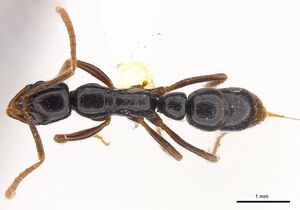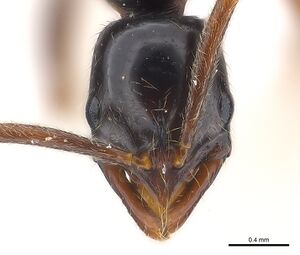Leptogenys orchidioides
| Leptogenys orchidioides | |
|---|---|

| |
| Scientific classification | |
| Kingdom: | Animalia |
| Phylum: | Arthropoda |
| Class: | Insecta |
| Order: | Hymenoptera |
| Family: | Formicidae |
| Subfamily: | Ponerinae |
| Tribe: | Ponerini |
| Genus: | Leptogenys |
| Species group: | quiriguana |
| Species: | L. orchidioides |
| Binomial name | |
| Leptogenys orchidioides Lattke, 2011 | |
The series seem to represent specimens taken from a single nest found in a shipment of orchids of the genus Odontoglossum by customs authorities. This raises the question of the nesting habits for this species, was the orchid collected as an epiphyte in the field along with the ants, or did the ants move into the plant later? Another interesting aspect about this series is the large ratio of queens versus workers: almost the same number (8w, 7q). (Lattke 2011)
Identification
Lattke (2011) - Median clypeal lobe laterally lamellate basad; mandible elongate, basal and external margins subparallel, weakly widening apicad; propodeal declivity mostly smooth with 3 – 5 transverse striae between teeth. Node subquadrate in dorsal view, wider posterad than anterad; anterior and lateral margins U-shaped in dorsal view.
A member of the quiriguana species group. The hairs on the mandibular inner margin are not seta such as those found on the same place in the mandibles of other groups, as they are flexuous in L. orchidioides and not stiff and wire-like.
Keys including this Species
Distribution
Distribution based on Regional Taxon Lists
Neotropical Region: Guatemala (type locality).
Distribution based on AntMaps
Distribution based on AntWeb specimens
Check data from AntWeb
Countries Occupied
| Number of countries occupied by this species based on AntWiki Regional Taxon Lists. In general, fewer countries occupied indicates a narrower range, while more countries indicates a more widespread species. |

|
Estimated Abundance
| Relative abundance based on number of AntMaps records per species (this species within the purple bar). Fewer records (to the left) indicates a less abundant/encountered species while more records (to the right) indicates more abundant/encountered species. |

|
Biology
|
Castes
Images from AntWeb
   
| |
| Worker. Specimen code casent0217001. Photographer Erin Prado, uploaded by California Academy of Sciences. | Owned by USNM, Washington, DC, USA. |
Male unknown.
Nomenclature
The following information is derived from Barry Bolton's Online Catalogue of the Ants of the World.
- orchidioides. Leptogenys orchidioides Lattke, 2011: 206, fig. 62 (w.q.) GUATEMALA.
Unless otherwise noted the text for the remainder of this section is reported from the publication that includes the original description.
Description
Worker
Metrics, holotype (paratypes, n = 4): HL 1.11 (1.09 – 1.16); HW 0.81 (0.78 – 0.81); ML 0.58 (0.58 – 0.63); EL 0.18 (0.18–0.18); SL 0.94 (0.96–0.99); PW 0.68 (0.68 – 0.68); WL 1.75 (1.64 – 1.70); PH 0.73 (0.71 – 0.73); PL 0.56 (0.53–0.53); DPW 0.53 (0.53–0.53) mm. CI 0.73 (0.70–0.73); MI 0.72 (0.72–0.81); OI 0.22 (0.22– 0.23); SI 1.16 (1.19–1.26); LPI 1.32 (0.00–1.38); DPI 0.95 (1.00 – 1.00).
Head subquadrate in full-face view; lateral margin broadly convex; posterior cephalic margin weakly convex; median clypeal lobe broadly triangular, laterally lamellate basad, apex pointed, no apical seta; lateral lobe narrow, widest towards median lobe, forming rounded angle; eye weakly convex in cephalic full-face view, laterally placed on head, length under one-fourth length of lateral cephalic margin. Head widest anterad. Scape smooth and shining with abundant piligerous punctulae, surpassing posterior cephalic border by less than one-fourth its length; funicular segments elongate; antennal segments II–IV equal in length; length of segment II twice its apical width, segments III–IV not as elongate; each segment slightly wider apicad than basad. Mandible elongate, basal and external margins parallel; basal margin broadly convex, 1 – 2 prominent hairs sometimes present on mandibular basal margin opposite median clypeal lobe; masticatory margin short with blunt apical tooth; mandibular dorsum mostly smooth and shining with scattered punctulae. Cephalic dorsum mostly smooth and shining with piligerous punctulae; clypeus mostly smooth with sparse weak striae and piligerous tubercles.
Dorsal mesosomal margin mostly continuous in lateral view, pronotal dorsal margin broadly convex, metanotum straight, metanotal groove weakly impressed, dorsal propodeal margin broadly convex, forming obtuse angle with straight to weakly convex declivitous margin. Modest triangular propodeal tooth present opposite spiracle. Mesosoma mostly smooth and shining with sparse piligerous punctulae, dorsum with weak undulations and punctulae of larger diameter; metapleuron with rugulae posteroventrad; mesometapleural suture distinctly impressed, scrobiculate; mesopleural carina well developed, widest anterad; metapleural-propodeal suture absent; propodeal spiracle elliptical with opening directed posterolaterally, broad depression present between spiracle and propodeal tooth; propodeal declivity mostly smooth with 3 – 5 transverse striae between teeth. Prosternum smooth and shining; mesonotum 2 × wider than long in dorsal view, metanotal groove smooth.
Petiole node subrectangular in lateral view, anteriorly inclined, anterior margin half height of mostly straight posterior margin, dorsal margin convex, node highest posterad; node mostly smooth and shining. Subpetiolar process subtriangular in lateral view, with long anteroventral margin. Node subquadrate in dorsal view, wider posterad than anterad; anterior and lateral margins U-shaped in dorsal view. Anterior postpetiolar margin broadly convex in lateral view, dorsal margin convex; constriction between abdominal segments III – IV broad; gaster mostly smooth and shining with scattered piligerous punctulae. Body black to dark brown with blue opalescence; mandibles, clypeus, legs, antennae, and gastral apex brown. Body with scattered erect and semi-erect hairs, some appressed hairs present, pubescence wanting. Coxae mostly smooth and shining; metacoxal dorsum with posterior rounded crest basad; pro- and metatibial apices lacking setae, mesotibial apex with seta.
Queen
Metrics (n = 2): HL 1.08 – 1.10; HW 0.80 – 0.82; ML 0.60 – 0.60; EL 0.18 – 0.18; SL 0.96 – 0.98; PW 0.68 – 0.68; WL 1.54 – 1.58; PH 0.56 – 0.58; PL 0.48 – 0.48; DPW 0.56–0.58 mm. CI 0.73–0.76; MI 0.73–0.75; OI 0.22 – 0.23; SI 1.20 – 1.20; LPI 1.17 – 1.21; DPI 1.17 – 1.21. Queen very much like worker except for more convex dorsal propodeal margin in lateral view, petiole node more compressed, enlarged gaster, and vestigial ocelli. Propodeal spiracle more elongate than worker.
Type Material
Holotype worker. Guatemala, 3-30-47, Br. 63953, 47-5066. One point-mounted worker deposited in National Museum of Natural History. – Paratypes. Seven workers and seven queens with same data as the holotype. Two workers on same pin as holotype. All deposited in USNM.
Etymology
The species name alludes to the apparent nesting site of the type series, an orchid. It is derived from the Greek for Orchid, Orchios.

